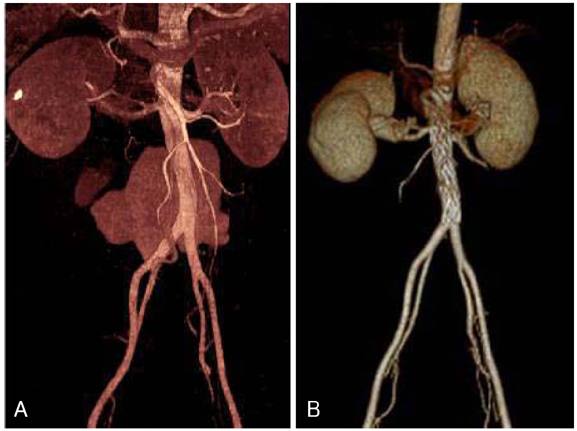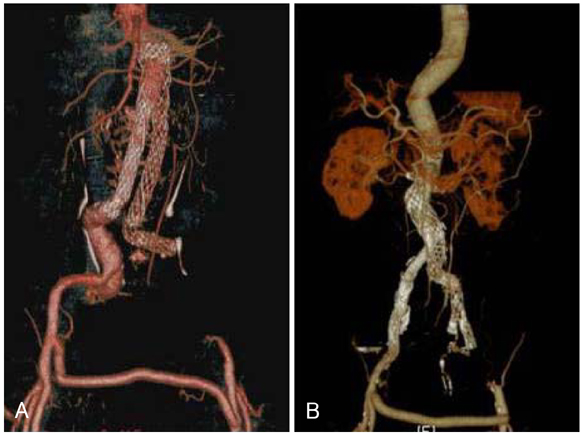Korean Circ J.
2007 Oct;37(10):459-463. 10.4070/kcj.2007.37.10.459.
Endovascular Abdominal Aortic Aneurysmal Repair:A Korean Perspective
- Affiliations
-
- 1Cardiology Division, Department of Internal Medicine, Yonsei Cardiovascular Hospital, Yonsei University College of Medicine, Seoul, Korea. whshim@yumc.yonsei.ac.kr
- KMID: 2227045
- DOI: http://doi.org/10.4070/kcj.2007.37.10.459
Abstract
- Endovascular aneurysm repair (EVAR) was initially introduced as a less invasive alternative to conventional open repair. EVAR was subsequently adopted as a treatment option for abdominal aortic aneurysm. In Korea, open repair is more widely available than EVAR, although EVAR can be performed in several hospitals. Due to the rapidly aging population in Korea, there has been a shift from private healthcare to government-regulated universal coverage and EVAR may be a more feasible option for cardiovascular interventionalists in these days. The improvement of EVAR was rapidly attained by many pioneers for the last two decades. Although issues such as indications and durability of EVAR remain to be elucidated, its application can be extended further of milder invasiveness-related effects on comorbidities and less discomfort to patients. Aortic stent-grafting has been performed for various aortoiliac pathologies over the last 13 years at our cardiovascular center.1-3) This article presents a comprehensive review on EVAR by focusing on the clinical trials, indications, complications, and expertise in decision making for EVAR.
Keyword
MeSH Terms
Figure
Reference
-
1. Kim BK, Park S, Ko YK, et al. Immediate and mid-term outcomes of the endovascular stent-graft treatement of abdominal aortic aneurysm. Korean Circ J. 2005. 35:583–590.2. Shim DK, Yoon YS, Chang BC, Lee DY, Shim WH. A case of complete resolution of aortc dissection in the descending thoracic aorta treated with endovascular stent-graft implantation. Korean Circ J. 2000. 30:1583–1588.3. Kang WC, Ko YG, Koo BK, et al. Favorable outcome of endovascular stent-graft implantation for stanford type B aortic dissection. Korean Circ J. 2003. 33:457–464.4. Parodi JC, Palmaz JC, Barone HD. Transfemoral intraluminal graft implantation for abdominal aortic aneurysms. Ann Vasc Surg. 1991. 5:491–499.5. Matsumura JS, Brewster DC, Makaroun MS, Naftel DC. A multicenter controlled clinical trial of open versus endovascular treatment of abdominal aortic aneurysm. J Vasc Surg. 2003. 37:262–271.6. Zarins CK, White RA, Schwarten D, et al. AneuRx stent graft versus open surgical repair of abdominal aortic aneurysms: multicenter prospective clinical trial. J Vasc Surg. 1999. 29:292–305.7. Brewster DC, Geller SC, Kaufman JA, et al. Initial experience with endovascular aneurysm repair: comparison of early results with outcome of conventional open repair. J Vasc Surg. 1998. 27:992–1003.8. Blum U, Voshage G, Lammer J, et al. Endoluminal stent-grafts for infrarenal abdominal aortic aneurysms. N Engl J Med. 1997. 336:13–20.9. Cuypers P, Buth J, Harris PL, Gevers E, Lahey R. Realistic expectations for patients with stent-graft treatment of abdominal aortic aneurysms. Eur J Vasc Endovasc Surg. 1999. 17:507–516.10. Beebe HG, Cronenwett JL, Katzen BT, Brewster DC, Green RM. Results of an aortic endograft trial: impact of device failure beyond 12 months. J Vasc Surg. 2001. 33:S55–S63.11. Holzenbein TJ, Kretschmer G, Thurnher S, et al. Midterm durability of abdominal aortic aneurysm endograft repair: a word of caution. J Vasc Surg. 2001. 33:S46–S54.12. Harris PL, Vallabhaneni SR, Desgranges P, Becquemin JP, van Marrewijk C, Laheij RJ. Incidence and risk factors of late rupture, conversion, and death after endovascular repair of infrarenal aortic aneurysms. J Vasc Surg. 2000. 32:739–749.13. Bernhard VM, Mitchell RS, Matsumura JS, et al. Ruptured abdominal aortic aneurysm after endovascular repair. J Vasc Surg. 2002. 35:1155–1162.14. Gorham TJ, Taylor J, Raptis S. Endovascular treatment of abdominal aortic aneurysm. Br J Surg. 2004. 91:815–827.15. Greenhalgh RM, Brown LC, Kwong GP, Powell JT, Thompson SG. Comparison of endovascular aneurysm repair with open repair in patients with abdominal aortic aneurysm (EVAR trial 1), 30-day operative mortality results: randomised controlled trial. Lancet. 2004. 364:843–848.16. EVAR Trial Participants. Endovascular aneurysm repair and outcome in patients unfit for open repair of abdominal aortic aneurysm (EVAR trial 2): randomised controlled trial. Lancet. 2005. 365:2187–2192.17. Prinssen M, Buskens E, Blankensteijn JD. The Dutch Randomised Endovascular Aneurysm Management (DREAM) trial: background, design and methods. J Cardiovasc Surg. 2002. 43:379–384.18. Blankensteijn JD, de Jong SE, Prinssen M, et al. Two-year outcomes after conventional or endovascular repair of abdominal aortic aneurysms. N Engl J Med. 2005. 352:2398–2405.19. Katzen BT, Dake MD, MacLean AA, Wang DS. Endovascular repair of abdominal and thoracic aortic aneurysms. Circulation. 2005. 112:1663–1675.20. Nevitt MP, Ballard DJ, Hallett JW Jr. Prognosis of abdominal aortic aneurysms: a population-based study. N Engl J Med. 1989. 321:1009–1014.21. Brewster DC, Cronenwett JL, Hallett JW Jr, Johnston KW, Krupski WC, Matsumura JS. Guidelines for the treatment of abdominal aortic aneurysms: report of a subcommittee of the Joint Council of the American Association for Vascular Surgery and Society for Vascular Surgery. J Vasc Surg. 2003. 37:1106–1117.22. Powell JT, Greenhalgh RM. Clinical practice: small abdominal aortic aneurysms. N Engl J Med. 2003. 348:1895–1901.23. Scott RA, Tisi PV, Ashton HA, Allen DR. Abdominal aortic aneurysm rupture rates: A 7-year follow-up of the entire abdominal aortic aneurysm population detected by screening. J Vasc Surg. 1998. 28:124–128.24. EVAR Trial Participants. Endovascular aneurysm repair versus open repair in patients with abdominal aortic aneurysm (EVAR trial 1): randomised controlled trial. Lancet. 2005. 365:2179–2186.25. Veith FJ, Baum RA, Ohki T, et al. Nature and significance of endoleaks and endotension: summary of opinions expressed at an international conference. J Vasc Surg. 2002. 35:1029–1035.26. White GH, May J, Waugh RC, Yu W. Type I and type II endoleaks: a more useful classification for reporting results of endoluminal AAA repair. J Endovasc Surg. 1998. 5:189–191.
- Full Text Links
- Actions
-
Cited
- CITED
-
- Close
- Share
- Similar articles
-
- Endovascular Aneurysm Repair for Abdominal Aortic Aneurysm: A Comprehensive Review
- Novel Technique to Rescue a Folded Aortic Endograft during Endovascular Aneurysm Repair
- Ruptured Abdominal Aortic Aneurysm with Antecedent Endovascular Repair of Abdominal Aortic Aneurysm
- Endovascular Repair of a Juxtarenal Abdominal Aortic Aneurysm Using a Chimney Graft
- The Complications and Their Management after Endovascular Aneurysm Repair for the Treatment of Abdominal Aortic Aneurysms





